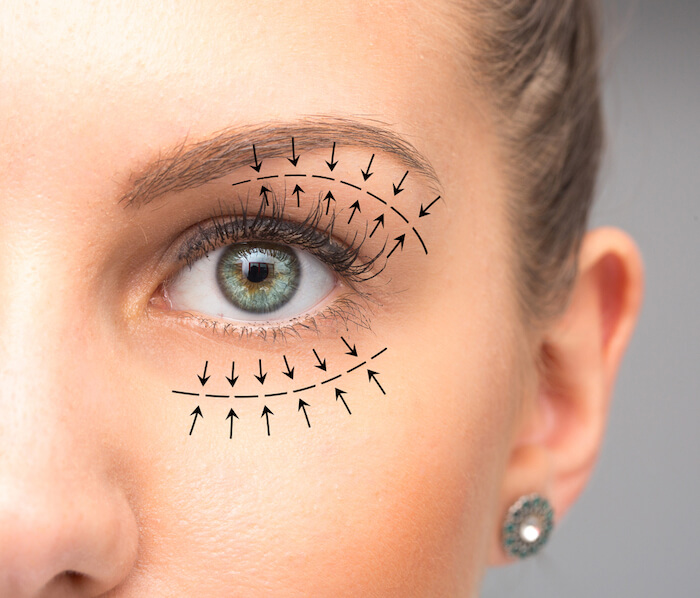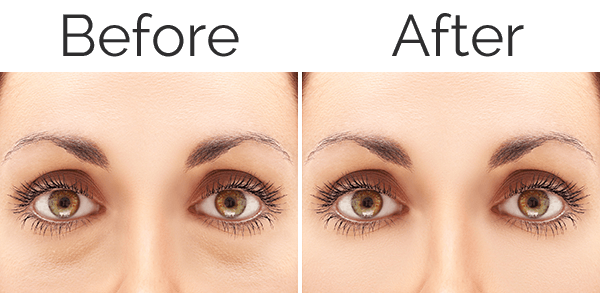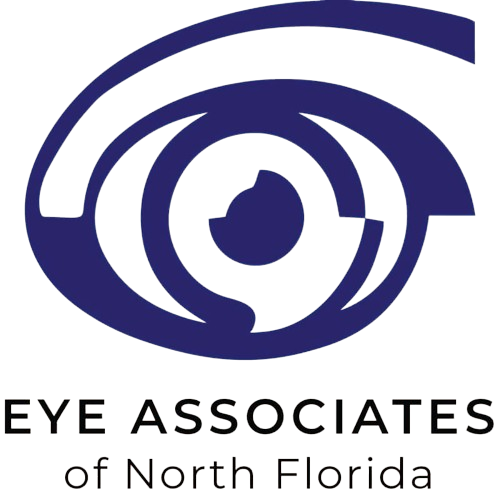Plastic Surgery In Tallahassee, FL
The anatomy around the eyes and orbit is both delicate and complex. Understanding the intricacy and functionality of the eyelid, tear ducts and orbit as well as the delicacy of the tissue is what an oculoplastic physician is trained in. An oculoplastic surgeon has training in both Ophthalmology and Plastic Reconstructive Surgery. The specialty of Oculoplastics is an art that combines the meticulous detailed microsurgical techniques of ophthalmology with the aesthetic understanding of plastic surgery.
Oculoplastic surgeons perform procedures such as the repair of droopy eyelids, repair of tear duct obstructions, orbital fracture repairs, removal of tumors in and around the eyes, eyelid reconstruction and facial rejuvenation procedures including laser skin resurfacing eye lifts, brow lifts, and facelifts.

Blepharoplasty
What Is Blepharitis?

Blepharoplasty in Tallahassee
Upper Lid Blepharoplasty
Upper lid blepharoplasty, also known as a “lid lift,” is a surgical procedure to remove excess skin and fatty tissue from the upper eyelids. This excess skin can occur with age, seasonal allergies, or from lifestyle issues such as sun exposure and smoking. There may also be a hereditary component. In many cases, this excess skin can give the patient a “tired” look. Extra effort may be needed to keep one’s eyes fully open due to this excess skin. In extreme cases, the excess skin can hang over the eyelid, interfering with vision and causing chronic skin irritation.
Upper eyelid blepharoplasty is an outpatient procedure. The incision is made in the natural lid crease of the eyelid. After the excess tissue is removed, tiny stitches are placed that will be removed in the office the following week. Because these incisions are strategically placed along the natural contours of the eyelid, the line is typically barely visible.
Lower Lid Blepharoplasty
Lower lid blepharoplasty is a surgical procedure to remove the excess fatty pads (“bags”) and skin from the lower lids. Typically, a fine incision is made just below the eyelashes. This incision may be extended if the correction of lower lid laxity is needed. Tiny stitches are placed to secure the tissue at the conclusion of the procedure. These stitches will be gently removed in the office the following week.
Is Blepharoplasty Right For Me?
The best candidates for upper and lower lid cosmetic blepharoplasty are those patients who are physically healthy and well informed about the improvements that can be achieved through surgery. Those who can benefit from blepharoplasty can be any age, from 30 to 80, although most patients are in their 40s, 50s, and 60s.
Your general health, as well as your eye health, will be carefully reviewed during your consultation. Your expectations and your anticipated outcomes will also be addressed during this visit.
Ptosis
What Is Ptosis?
Ptosis is a condition in which the upper eyelid(s) droops. The eyelid may droop only slightly or it may droop enough to partially or completely cover the pupil, restricting or obscuring the field of vision. Ptosis should not be confused with extra skin, fat or muscle in the eyelid area. Those issues are typically addressed with cosmetic blepharoplasty surgery. When ptosis can be shown to reduce peripheral vision, its surgical correction may be covered by insurance. If the degree of ptosis is not severe, it may be considered elective surgery and can be corrected as a cosmetic procedure.
The most common type of ptosis is adult-onset, caused by a weakening or dehiscence of the attachment between the levator muscle (the muscle that raises the upper lid) and the tarsus near the eyelid margin. This typically occurs as a result of the aging process, after cataract surgery, following contact lens wear, or from an injury. In certain cases of sudden onset of ptosis, there may be other causes that should be evaluated by an oculoplastic specialist.
Treatment
Ptosis surgery is an outpatient procedure that involves tightening the levator muscle that lifts the lid. The surgical approach taken depends on specific findings and testing performed during the consultation with one of our oculoplastic surgeons. Your surgeon will discuss your treatment options fully and will perform all the proper testing to determine whether your ptosis may be deemed medically necessary by your insurance carrier.
Tearing & Treatment Of Lacrimal Drainage Disorder
In order for the eye to function properly, it must be kept well lubricated. Accordingly, there is an extensive system of glands that produce different components of the tears that work together to form a functional tear film. This tear film is crucial to protecting the delicate surface of the eye, keeping the eye comfortable, and maintaining crisp vision. However, if there are too many tears covering the eye, this can cause significant problems. Patients with excess tearing will often notice blurred vision, constant tears streaming down the face, redness and skin irritation from constant dabbing of tears, and recurrent infections.
What Causes Excessive Tearing?
The exact cause of excessive tearing can sometimes be difficult to elicit. This problem can occur if there is an overproduction of tears, decreased drainage of tears, or a combination of the two.
Overproduction
Overproduction of tears may be related to several ocular conditions that will signal your tear gland (lacrimal gland), to produce extra tears. Causes include:
- Dry eyes
- Allergies
- Ocular surface irritation
- Infections
- Eyelid inflammation (blepharitis)
The aforementioned conditions can be treated with artificial tears, allergy drops, anti-inflammatory drops, antibiotic drops or ointments, and oral medications.
Decreased drainage
Each eyelid has two small openings (puncta), one on the upper lid and one on the lower lid, which lead into a drainage system, which will empty into a sac (lacrimal sac), that ultimately passes through a duct (Nasolacrimal duct), into the nose. Anatomic variations at any point along this passageway can cause excess tearing. In addition to tearing, a blockage along the drainage system can cause recurrent infections. Symptoms of these infections include warmth and redness in the area in between the eye and nose, purulent discharge, and a pink irritated eye.
The blockage of the tear drainage system can be confirmed in the office by performing a small non-invasive test in the office where a salt solution is irrigated through the tear drain. Depending on the results, corrective options can be discussed. Options to improve drainage may be as simple as starting a regimen of steroid drops, but in certain cases, surgery may be the best option.
What Are The Surgical Options?
Punctoplasty: This is an in-office procedure done under local anesthesia where the small openings of the tear drain (puncta), are dilated with a small instrument and snipped open with very fine specialized instruments. Minimal swelling may be encountered afterward, but normal activity can be resumed almost immediately.
Probe and Tube: This is a procedure performed in the operating room under general anesthesia, and takes about 15 minutes. The procedure involves inserting a small, flexible, temporary tube into the tear duct. The tube functions to dilate any narrowed area along with the drainage system. The tube stays in place for approximately 3 months and is painlessly removed in the office. While the tube is in place, tearing is still expected but should improve upon removal of the tube. There is no incision or stitches, and as such recovery is fairly simple, and normal activity is resumed the following day. It is useful in cases of partial tear duct obstructions.
Dacryocystorhinostomy (DCR): This a slightly more involved procedure done in the operating room under general anesthesia which takes about 1 hour to perform. An approximately 1-inch external incision is created in the area in between the eye and nose. The tear sac is identified and opened directly into the nose, through a small passage through the nasal bone. This effectively bypasses blockages of the nasolacrimal duct. A temporary tube is placed to keep the passage open. External stitches are removed in 1 week, and the patient may expect a very thin scar that in most cases is not evident after several months. This surgery is useful for complete tear duct blockages that result in severe tearing and oftentimes, recurrent infections.
Conjunctivodacryocystorhinostomy (CDCR): This is a variation of the DCR described above. It involves placing a pyrex glass tube (Jones tube) into the corner of the eye socket that empties directly into the nose. It is typically used in patients who had a previous DCR procedure that either didn’t resolve the blockage or overtime has closed up again.
After a thorough evaluation with one of our oculoplastic specialists, an appropriate treatment plan can be initiated.
Tumors of the Eyelid
Eyelid tumors are abnormal growths found on the lids. These growths may be benign or malignant. A variety of benign growths occurs, including ductal cysts, inclusion cysts, and styes and chalazia. Skin cancer on the eyelid is definitely associated with sun exposure. Many skin cancers can occur on the lid, including basal cell carcinoma, squamous cell carcinoma, meibomian (sebaceous) gland carcinoma and melanoma.
Symptoms
In many cases, there may be no symptoms of eyelid cancer. It may present as a growth on the eyelid or an area of irregularity or loss of lashes. In some cases, pain, discharge or bleeding may occur. It is important to notify your eye doctor if you notice any changes in the appearance of your eyelids.
Diagnosis
The diagnosis of an eyelid tumor is best begun with a careful clinical examination by one of our oculoplastic surgeons, who have special training in eyelid cancers and lid lesions. Photographs may be taken of your eyelids for further evaluation and documentation. A biopsy may be necessary to determine the nature of the eyelid tumor and recommended treatment.
Treatment
Some benign tumors do not require any treatment. Other tumors may need surgical intervention, medical treatment or radiation. Depending on the nature and location of the eyelid tumor, one of our oculoplastic surgeons may work together with a Mohs dermatologic surgeon to allow for the removal of cancer and reconstruction of the eyelid area.
Orbital Tumors
The orbit is the cavity or socket of the skull in which the eye is situated. Tumors and inflammation can occur behind the eye in the orbit. This can cause the eye to push forward, leading to a bulging of the eye (proptosis). It is extremely important to seek medical attention for orbital tumors as they may be sight and life-threatening.
The most common types of orbital tumors vary considerably by age, but include:
- cysts
- vascular lesions
- lymphomas
- neurogenic tumors
- secondary tumors (from cancer elsewhere in the body, i.e. metastases)
Symptoms
Many patients with orbital tumors notice a bulging or prominence of the eyeball. Some may notice the double vision. Infections, inflammation and certain orbital tumors may cause pain. Orbital tumors are sometimes found during a CT scan or MRI of the head or sinuses.
Diagnosis
Initially, a careful examination by one of our oculoplastic specialists is critical. The patient’s symptoms, vision, general health and structure and function of the surrounding orbital tissues will be evaluated. If necessary, additional testing may be performed. CT scans, MRI’s and ultrasound tests may help in determining the diagnosis. Many orbital tumors are diagnosed by a surgical biopsy. A specimen is then sent to a pathologist to determine the exact diagnosis.
Treatment
The recommended treatment depends on the type of tumor present. Not all orbital tumors require surgical excision. In some, radiation, chemotherapy or immunotherapy may be indicated.
If you are concerned that you may have an orbital tumor, please make an appointment with one of our skilled oculoplastic surgeons as soon as possible.
Entropian & Ectropion
Entropion
Entropion is an eyelid dysfunction that occurs when the upper or lower eyelid and eyelashes turn inward towards the eye, causing the lid and lashes to rub against the cornea and conjunctiva.
Causes of Entropion
- relaxation of eyelid tissue due to aging changes
- chronic infections with scarring on the inner surface of the eyelid
- traumatic eyelid injuries
- tumors
Symptoms of Entropion
- excessive tearing
- foreign body sensation
- sensitivity to light and the wind
- redness and pain of the eye
- impaired vision
Management of Entropion
Several surgical procedures may be used to tighten the eyelid and its attachments to improve the lid position. Taping the lid or lubricating the eye with drops or ointment may provide temporary relief and protection for the eye.
Entropion Vs. Ectopion: What’s The Difference?
Ectropion
Ectropion is an eyelid dysfunction that occurs when the lower eyelid turns outward and does not protect the eye. Consequently, the cornea and conjunctiva may become exposed and irritated. Often the edge (margin) of the lower lid is red. Ectropion can affect one or both lower eyelids.
Causes of Ectropion
- relaxation of eyelid tissue due to aging changes
- untreated skin cancers or skin disease
- trauma
- contraction of scar tissue of the surrounding skin
- eyelid or facial surgery
- can occur secondary to facial nerve palsy
Symptoms of Ectropion
- excessive tearing
- mucus discharge
- chronic eye infections
- eye irritation
- impaired vision
- sensitivity to light and the wind
- redness of the lid and/or conjunctiva
Management of Ectropion
Artificial tears and lubricating ointments can be used to moisten the cornea to prevent dryness. When ectropion is caused by stretching of the eyelid’s supporting structures, surgery may be recommended to repair the involved eyelid and help protect the eye. One of our oculoplastic surgeons can review the best option for your situation.
Thyroid Eye Disease
Thyroid eye disease (TED) can cause inflammation and associated swelling of the muscles that allow the eye to move in different directions. Since each muscle does not swell the exact same amount, this may result in double vision or blurred vision.
Diagnosis And Treatment
Evaluation and treatment of abnormal thyroid levels in your bloodstream by your primary physician or endocrinologist is important. Even when the thyroid function studies are normal, there may be eye findings related to the thyroid. Surgical intervention may be suggested, including orbital decompression, eye muscle surgery, and/or eyelid surgery.
Careful expert monitoring of any changes in vision, eye pressure, lid retraction or proptosis (bulging eyes) should be done on a routine basis in patients with known thyroid disease. In addition, your doctor will do a careful examination of the back of the eye to look for changes in the optic nerve. Visual field (peripheral vision) testing should also be done regularly.







